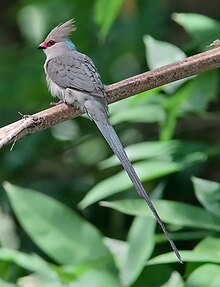The mousebirds are birds in the order Coliiformes. They are the sister group to the clade Cavitaves, which includes the Leptosomiformes (the cuckoo roller), Trogoniformes (trogons), Bucerotiformes (hornbills and hoopoes), Piciformes (woodpeckers, toucans, and barbets) and Coraciformes (kingfishers, bee-eaters, rollers, motmots, and todies).[2] This group is now confined to sub-Saharan Africa, and it is the only bird order confined entirely to that continent, with the possible exception of turacos which are considered by some as the distinct order Musophagiformes, and the cuckoo roller, which is the only member of the order Leptosomiformes, and which is found in Madagascar but not mainland Africa. Mousebirds had a wider range in the Paleogene, with a widespread distribution in Europe and North America during the Paleocene.[3][4]
| Mousebirds
| |
|---|---|

| |
| Blue-naped mousebird (Urocolius macrourus) | |
| Scientific classification | |
| Domain: | Eukaryota |
| Kingdom: | Animalia |
| Phylum: | Chordata |
| Class: | Aves |
| Clade: | Coraciimorphae |
| Order: | Coliiformes Murie, 1872 |
| Family: | Coliidae Swainson, 1837 |
| Genera | |
Mousebirds are slender greyish or brown birds with soft, hairlike body feathers. They are typically about 10 cm (3.9 in) in body length, with a long, thin tail a further 20–24 cm (7.9–9.4 in) in length, and weigh 45–55 g (1.6–1.9 oz).[5] They are arboreal and scurry through the leaves like rodents, in search of berries, fruit and buds. This habit, and their legs, gives rise to the group's English name. They are acrobatic, and can feed upside down. All species have strong claws and reversible outer toes (pamprodactyl feet). They also have crests and stubby bills.
Mousebirds are gregarious, again reinforcing the analogy with mice, and are found in bands of about 20 in lightly wooded country. These birds build cup-shaped twig nests in trees, which are lined with grasses. Clutches of two to three eggs are typically laid.[6]
The mousebirds could be considered "living fossils" as the six species extant today are merely the survivors of a lineage that was massively more diverse in the early Paleogene and Miocene. There are comparatively abundant fossils of Coliiformes, but it has not been easy to assemble a robust phylogeny. The family is documented to exist from the Early Paleocene onwards; by at least the Late Eocene, two families are known to have existed, the extant Coliidae and the longer-billed prehistorically extinct Sandcoleidae.[3]
The latter were previously a separate order,[7] but eventually it was realized that they had come to group ancestral Coraciiformes, the actual sandcoleids and forms like Neanis together in a paraphyletic assemblage. Even though the sandcoleids are now assumed to be monophyletic following the removal of these taxa, many forms cannot be conclusively assigned to one family or the other.[8] The genus Selmes, for example, is probably a coliid, but only distantly related to the modern genera.[9]
Extinct Coliiformes occupied a wide range of ecologies. Sandcoleids in particular often preserve uncrushed seeds on their stomachs, while bearing talons similar to those of modern birds of prey.[10]